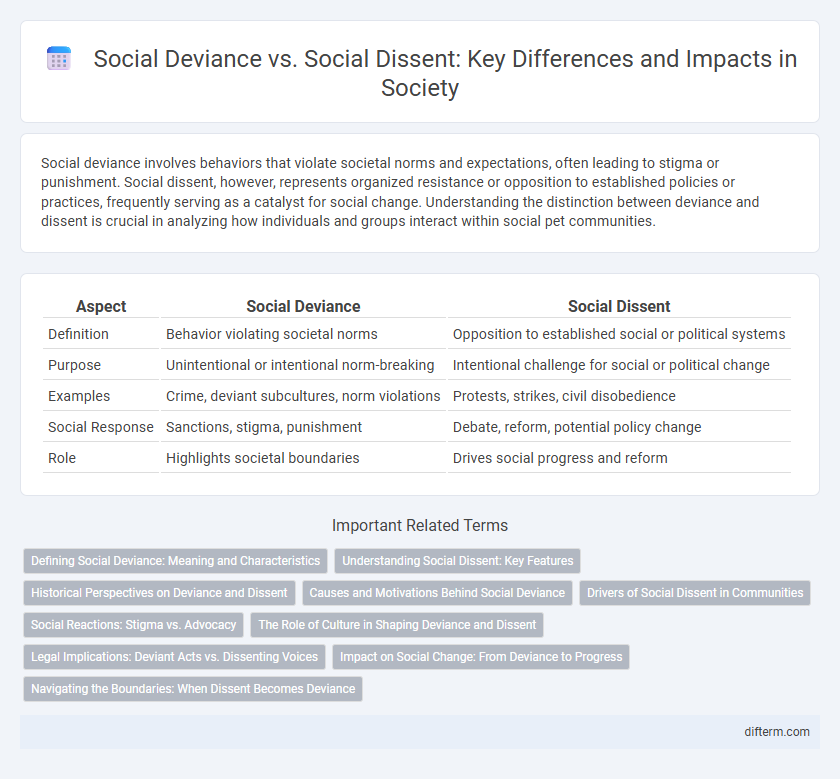Social deviance involves behaviors that violate societal norms and expectations, often leading to stigma or punishment. Social dissent, however, represents organized resistance or opposition to established policies or practices, frequently serving as a catalyst for social change. Understanding the distinction between deviance and dissent is crucial in analyzing how individuals and groups interact within social pet communities.
Table of Comparison
| Aspect | Social Deviance | Social Dissent |
|---|---|---|
| Definition | Behavior violating societal norms | Opposition to established social or political systems |
| Purpose | Unintentional or intentional norm-breaking | Intentional challenge for social or political change |
| Examples | Crime, deviant subcultures, norm violations | Protests, strikes, civil disobedience |
| Social Response | Sanctions, stigma, punishment | Debate, reform, potential policy change |
| Role | Highlights societal boundaries | Drives social progress and reform |
Defining Social Deviance: Meaning and Characteristics
Social deviance refers to behaviors or actions that violate established societal norms and expectations, distinguishing themselves from social dissent by lacking a political or reformative intent. Key characteristics of social deviance include norm violation, social disapproval, and varying degrees of severity depending on cultural context. Unlike social dissent, which challenges existing power structures to inspire change, social deviance typically undermines social order without aiming for collective transformation.
Understanding Social Dissent: Key Features
Social dissent involves the collective expression of disagreement or opposition to established social norms, policies, or authorities, often aiming to bring about social or political change. It is characterized by organized actions such as protests, demonstrations, or advocacy campaigns that challenge prevailing power structures. Understanding social dissent requires recognizing its role as a catalyst for reform, distinct from social deviance, which typically denotes norm violations without a collective goal or reformist intent.
Historical Perspectives on Deviance and Dissent
Historical perspectives on social deviance and social dissent reveal distinct patterns where deviance often refers to behaviors violating established norms, while dissent embodies organized opposition to dominant social or political systems. Early sociologists like Emile Durkheim viewed deviance as a necessary force for social change, whereas dissent has been linked to movements challenging injustice, such as civil rights activism. Throughout history, understanding the interplay between deviance and dissent provides critical insights into how societies manage conformity, control, and progress.
Causes and Motivations Behind Social Deviance
Social deviance arises from factors such as social inequality, cultural norms, and psychological stress, driving individuals to breach established societal rules. Motivations behind deviance often include the pursuit of alternative status, economic gain, or rebellion against perceived injustices. Unlike social dissent, which seeks systemic change through organized protest, deviance typically reflects personal or group responses to social strain without a formal agenda.
Drivers of Social Dissent in Communities
Social dissent in communities is often driven by systemic inequalities, lack of political representation, and perceived injustices related to economic disparity and social exclusion. Cultural conflicts and the erosion of trust in institutions amplify collective grievances, motivating collective action against dominant norms. Access to social media platforms also accelerates the organization and visibility of dissent movements by facilitating communication and mobilization.
Social Reactions: Stigma vs. Advocacy
Social deviance often triggers stigma as society labels behaviors or identities that deviate from norms as undesirable, leading to social exclusion and discrimination. In contrast, social dissent tends to inspire advocacy, mobilizing groups to challenge existing power structures and promote social change. The dynamics of social reactions reveal how stigma reinforces conformity, while advocacy facilitates resistance and transformation.
The Role of Culture in Shaping Deviance and Dissent
Culture profoundly shapes perceptions of social deviance and dissent by defining norms and acceptable behaviors within a society. Cultural values influence which actions are labeled as deviant or dissenting, often reflecting power dynamics and social control mechanisms. Understanding cultural context is essential to analyze how behaviors challenge or conform to societal expectations.
Legal Implications: Deviant Acts vs. Dissenting Voices
Deviant acts often violate established legal codes, resulting in formal sanctions such as fines, imprisonment, or community service, reflecting society's need to maintain order. In contrast, social dissent typically involves non-violent expression of opposition, protected under constitutional rights like freedom of speech and assembly, though it may still face legal challenges or restrictions. Understanding the distinction between punitive measures for deviance and legal protections for dissent highlights the complex balance lawmakers must achieve between order and civil liberties.
Impact on Social Change: From Deviance to Progress
Social deviance challenges accepted norms by breaking societal rules, often causing disruption but paving the way for re-evaluation of values and potential reform. Social dissent actively questions and resists established authority or policies, serving as a catalyst for organized movements that drive legislative change and cultural shifts. Both deviance and dissent contribute to social change by exposing injustices and inspiring progress toward more equitable social structures.
Navigating the Boundaries: When Dissent Becomes Deviance
Social deviance refers to behaviors that violate societal norms, whereas social dissent involves expressing opposition within accepted frameworks. Navigating the boundaries between dissent and deviance requires understanding cultural context, legal standards, and the intent behind actions. When dissent escalates into deviance, it often challenges social order and prompts reevaluation of normative limits.
social deviance vs social dissent Infographic

 difterm.com
difterm.com